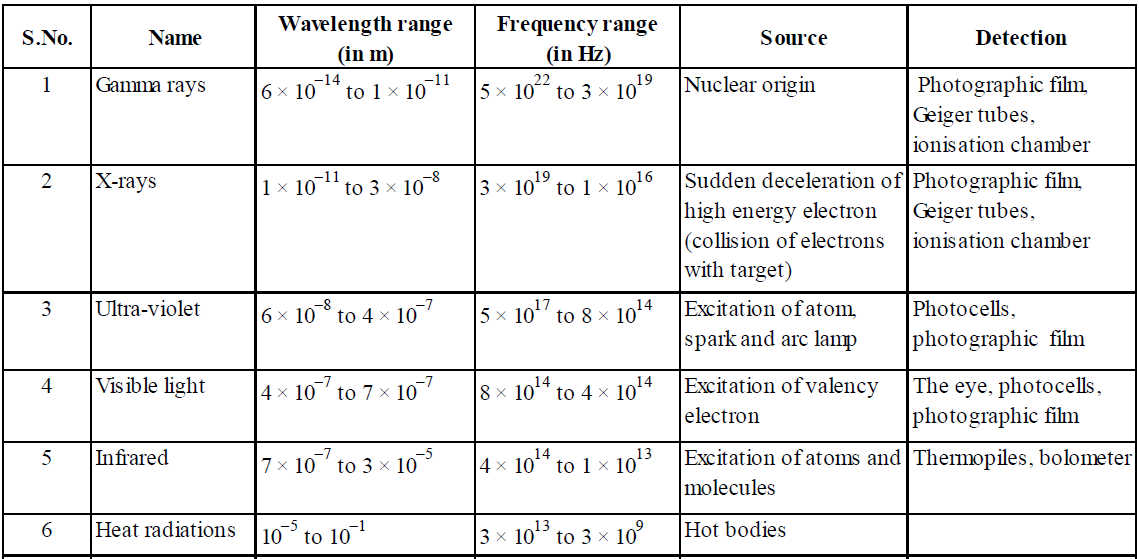| Electromagnetic Waves NEET and AIIMS Special |
| Electromagnetic Waves Refresher Course |
| Electromagnetic Waves Concept Course |
| Electromagnetic Waves : Brain Map |
| Reference Book Physics: Electromagnetic Waves |
| H C Verma Physics Exercise Solution:Electromagnetic Waves |
| Resnick Halliday Physics: Electromagnetic Waves |
| Resnick Halliday Physics: Electromagnetic Waves Solution |
About this unit
Need for displacement current. Electromagnetic waves and their characteristics (qualitative ideas only). Transverse nature of electromagnetic waves. Electromagnetic spectrum (radio waves, microwaves, infrared, visible, ultraviolet, x-rays, gamma rays) including elementary facts about their uses.
ELECTROMAGNETIC WAVES
DISPLACEMENT CURRENT
It is that current which comes into play in a region, where electric field (and hence the electric flux) is changing with time.
The displacement current is given by

where  = absolute permittivity (or permittivity of free space) and
= absolute permittivity (or permittivity of free space) and
 = rate of change of electric flux.
= rate of change of electric flux.
In case of a steady electric flux linked with a region, the displacement current is maximum.
The current in the electric circuit which arises due to flow of electrons in the connecting wires of the circuit, in a defined closed path is called conduction current.
MAXWELL’S MODIFICATION OF AMPERE’S CIRCUITAL LAW
In 1864, Maxwell showed that Ampere’s circuital law is logically inconsistent for non-steady currents. He modified Ampere’s law as (Sum of conduction current and displacement current) 
The term  is displacement current. It is that current which comes into existence, in addition to the conduction current, whenever the electric field and hence the electric flux changes with time.
is displacement current. It is that current which comes into existence, in addition to the conduction current, whenever the electric field and hence the electric flux changes with time.
MAXWELL’S EQUATION
Maxwell found that all the basic principles of electromagnetism can be formulated in terms of four fundamental equations, called Maxwell’s equation. These are :
GAUSS’S LAW FOR ELECTROSTATICS
According to Gauss’s law the total electric flux through any closed surface is equal to the net charge inside that surface divided by εo
i.e., 
This law relates the electric field to charge distribution, whereas electric field lines originate from positive (+ive) charge and terminate on negative (–ive) charge. The differential form of this law is


where ρ is volume charge density and εo is the permittivity of free space.
GAUSS’S LAW FOR MAGNETISM
It states that the net magnetic flux through a closed surface is zero. It means that number of magnetic field lines that enter a closed volume must be equal to number of field lines leaving that volume
i.e., 
It means that magnetic monopole cannot exists in nature. The differential form of this law is 
FARADAY’S LAW
This law states that the line integral of the electric field around any closed path (which equals the e.m.f.) equals the rate of change of magnetic flux through any surface area bounded by that path.
i.e., 
The consequence of this law is that, if we keep any conducting loop in a time varying magnetic field, then an induced current, flows in that conducting loop. The differential form of this law is

This law describes a relationship between an electric field and a changing magnetic flux.
MODIFIED AMPERE-MAXWELL LAW
It states that “ the line integral of magnetic field around any closed path is determined by the sum of the net conduction current through that path and the rate of change of electric flux through any surface bounded by that path
i.e., 

It describes the relationship between magnetic and electric fields and electric current. The differential form of this law is

ELECTROMAGNETIC WAVES
Maxwell-on the basis of four basic equations of electromagnetism theoretically predicted the existence of electromagnetic waves. An electromagnetic wave is the one constituted by oscillating electric and magnetic fields which oscillate in two mutually perpendicular planes. The wave itself propagates in a direction perpendicular to both of the directions of oscillations of electric and magnetic fields.
PROPERTIES OF ELECTROMAGNETIC WAVES
- The direction of oscillations of E and B fields are perpendicular to each other as well as to the direction of propagation. Electromagnetic waves are transverse in nature.
- The electric and magnetic field oscillate in same phase.
- The electromagnetic waves travel through vacuum with the same speed of light
- The energy density of electric field is
 and that of magnetic field is
and that of magnetic field is , so the energy density of the electromagnetic wave is
, so the energy density of the electromagnetic wave is 
where E and B are the instantaneous values of the electric and magnetic field vectors.
- The ratio

PRODUCTION OF ELECTROMAGNETIC WAVES
An accelerated charge emits electromagnetic waves. An oscillating charge, as in an LC-circuit has non-zero acceleration, it continues to emit electromagnetic waves. The frequency of electromagnetic waves is the same as that of the oscillating charge.
Hertz’s experiment : In 1888, Hertz succeeded in experimentally confirming the existence of electromagnetic waves. By using oscillator LC-circuits, he not only produced and detected electromagnetic waves, but also demonstrated their properties of reflection, refraction and interference and established beyond doubt that light radiation has wave nature.
KEEP IN MEMORY
- The amplitudes of electric and magnetic fields in free space, in electromagnetic waves are related by E0 = cB0 or

- The velocity of electromagnetic wave does not depend on amplitude of field vectors.
- The electric vector of an electromagnetic wave is responsible for the optical effects and is called a light vector.
- In a plane electromagnetic wave, the average energy densities of electric and magnetic fields are equal.
In vacuum, the average electric energy density is given by, 
The average magnetic energy density is given by
Also, 

∴ Total average energy density
= uE + uB = 2uE = 2uB 
- Poynting vector : When an electromagnetic wave advances, the electromagnetic energy flows in the direction . The total energy flowing perpendicularly per second per unit area into the space in free space is called a poynting vector where

The SI unit of S is watt/m2
- The intensity of a sinusoidal plane electromagnetic wave is defined as average value of poynting vector taken over one cycle. Thus,
- Radiation pressure : The pressure exerted by electromagnetic waves is called as radiation pressure (P). When an electromagnetic wave with Poynting vector is incident on a perfectly absorbing surface, then radiation pressure on surface is

ELECTROMAGNETIC SPECTRUM
All the known radiations form a big family of electromagnetic waves according to frequency or wavelength. We call this family as the complete electromagnetic spectrum. It includes: Gamma rays, X-rays, ultraviolet light, visible light, infrared light, microwaves and radio waves.


USES OF ELECTROMAGNETIC WAVES
The following are some of the uses of electromagnetic waves
- Radio waves are used in radio and T.V. communication systems.
- Microwaves are used in microwave oven.
- Infrared radiations are used (a) in revealing the secret writings on the ancient walls (b) in greenhouses to keep the plants warm (c) in warfare, for looking through haze, fog or mist as these radiations can pass through them.
- Ultraviolet radiations are used in the detection of invisible writing, forged documents, fingerprints in forensic laboratory and to preserve the food stuffs.
- The study of infrared, visible and ultraviolet radiations help us to know through spectra, the structure of the molecules and arrangement of electrons in the external shells.
- X-rays can pass through flesh and blood but not through bones. This property of X-rays is used in medical diagnosis, after X-rays photographs are made. The study of X-rays has revealed the atomic structure and crystal structure.
- The study of γ-rays provides us valuable information about the structure of the atomic nuclei
- Super high frequency electromagnetic waves (3000 to 30,000 MHz) are used in radar and satellite communication.
- Electromagnetic waves (frequency 50 to 60 Hz) are used for lighting. These are weak waves having wavelength 5 × 106 to 6 × 106 m and can be produced from A.C. circuits.
KEEP IN MEMORY
Greenhouse effect : It is the phenomenon which keeps the earth’s surface warm at night. The earth absorbs solar radiation and reflects back only infrared rays due to its low temperature. These rays are reflected back by the clouds and the gas molecules of the lower atmosphere. This keeps the earth’s surface warm at night.
PROPAGATION OF RADIO WAVES THROUGH THE ATMOSPHERE
It takes place in three ways :
- Ground wave propagation
- Sky wave propagation
- Space wave propagation
GROUND WAVE PROPAGATION
When the radio wave travel directly from one point to another following the surface of the earth, it is called ground or surface wave. This type of transmission is possible only with waves of wavelengths above 200 m or frequencies below 1500 kHz.
SKY WAVE PROPAGATION
When a radio wave is directed towards the sky and is reflected by the ionosphere towards desired location on the earth, it is called sky wave. This method is useful for the transmission of waves of wavelengths less than 200 m or frequencies above 1500 kHz upto 30 MHz.
SPACE WAVE PROPAGATION
For the transmission of television signals (frequencies in the range 100-200 MHz), space wave propagation method is used, in which the wave travels directly from a high transmitting antenna to the receiving antenna. The relation between the height ‘h’ of the transmitting antenna above the ground level and the distance ‘d’ upto which TV signal can be received is  = range of a TV tower where R is the radius of the earth.
= range of a TV tower where R is the radius of the earth.
